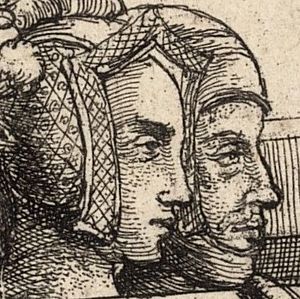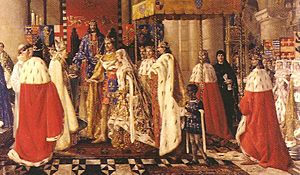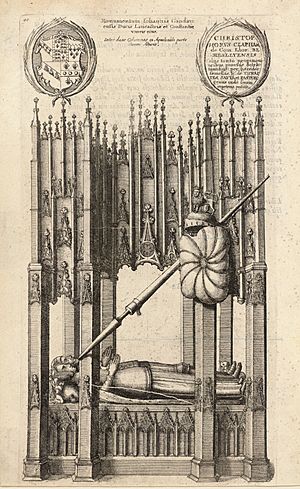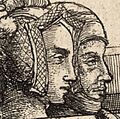Blanche of Lancaster facts for kids
Quick facts for kids Blanche |
|
|---|---|
| Duchess of Lancaster | |

The Duke and Duchess of Lancaster on their tomb monument in St Paul's Cathedral, as depicted in 1658 by Wenceslaus Hollar.
|
|
| Born | 25 March 1342 Bolingbroke Castle, Lincolnshire, Kingdom of England |
| Died | 12 September 1368 (aged 26) Tutbury Castle, Staffordshire, Kingdom of England |
| Burial | St Paul's Cathedral |
| Spouse | John of Gaunt |
| Issue more... |
|
| House | Plantagenet |
| Father | Henry of Grosmont, Duke of Lancaster |
| Mother | Isabel of Beaumont |
Blanche of Lancaster (born March 25, 1342 – died September 12, 1368) was an important member of the English royal family. She belonged to the House of Plantagenet. Blanche was the daughter of Henry of Grosmont, Duke of Lancaster, who was one of the richest and most powerful nobles in England.
She was the first wife of John of Gaunt, a son of King Edward III. Blanche was also the mother of King Henry IV and the grandmother of King Henry V.
Contents
Blanche's Family Background
Blanche was born on March 25, 1342. She was the younger daughter of Henry of Grosmont, the first Duke of Lancaster, and his wife, Isabel de Beaumont.
Blanche and her older sister, Maud, Countess of Leicester, were born at Bolingbroke Castle. Maud married twice but did not have any children who survived. Because of this, when Maud passed away, Blanche inherited all of her father's important titles and large estates. This made Blanche very wealthy and influential.
Marriage to John of Gaunt
On May 19, 1359, Blanche married her third cousin, John of Gaunt. John was the third son of King Edward III. Their wedding took place at Reading Abbey in Reading, Berkshire. The entire royal family attended the wedding, and the King gave Blanche many valuable gifts.
When Blanche's father died in 1361, his title of Duke of Lancaster ended because he had no sons. However, because John of Gaunt was married to Blanche, he became the Earl of Lancaster, Earl of Derby, Earl of Lincoln, and Earl of Leicester. He received these titles after Blanche's older sister, Maud, died in 1362. Later, John of Gaunt was also given the title of Duke of Lancaster. These titles gave him great power and influence in England.
How People Described Blanche
After Blanche's death, a writer named Jean Froissart described her as "young and pretty." Another famous writer, Geoffrey Chaucer, wrote a poem called Book of the Duchess. Many people believe this poem was inspired by Blanche. In the poem, Chaucer described "White" (who is thought to be Blanche) as "rosy, fresh, and lively." He also wrote about her beautiful, smooth neck.
Their Happy Marriage
Many historians believe that Blanche and John of Gaunt had a very happy marriage. One reason for this belief is that John of Gaunt chose to be buried next to Blanche, even though he married two more times after her death. Also, Chaucer's poem about love and sadness is thought to be about their relationship, which suggests a deep connection.
Blanche and John of Gaunt had seven children together. Sadly, only three of them lived to become adults.
Blanche's Death and Legacy
Blanche passed away on September 12, 1368, at Tutbury Castle in Staffordshire. She was only 26 years old. Her husband, John of Gaunt, was away from England at the time.
It is thought that Blanche might have died from the Black Death, a terrible disease that was common in Europe during that period. Her funeral was held at St Paul's Cathedral in London. It was a very grand event, attended by many important nobles and church leaders. John of Gaunt honored Blanche's memory every year for the rest of his life.
Poems and Memorials
In 1373, Jean Froissart wrote a long poem called Le Joli Buisson de Jonece. This poem remembered both Blanche and Philippa of Hainault, who was John of Gaunt's mother and had died in 1369.
It is also believed that Geoffrey Chaucer wrote his famous poem, The Book of the Duchess, to honor Blanche. Chaucer was a young writer at the time. Many people think the poem was meant to help John of Gaunt deal with his sadness over Blanche's death. The poem tells a story about a knight who is deeply grieving, which might represent John of Gaunt's own sorrow.
In 1374, six years after Blanche died, John of Gaunt ordered a special tomb for himself and Blanche. This beautiful monument was built by the mason Henry Yevele in St Paul's Cathedral. It was finished in 1380. When John of Gaunt died in 1399, he was buried next to Blanche. Their tomb was special because the statues of them had their right hands joined together, showing their bond.
Blanche's Children
Blanche and John of Gaunt had seven children. Three of them lived to be adults:
- Philippa of Lancaster (born March 31, 1360 – died July 19, 1415), who became the wife of John I of Portugal.
- John of Lancaster (born around 1362/1364); he died as a baby.
- Elizabeth of Lancaster (born February 21, 1363 – died November 24, 1426); she married three times.
- Edward of Lancaster (born and died in 1365).
- John of Lancaster (born May 4, 1366); he also died as a baby.
- Henry IV of England (born April 15, 1367 – died March 20, 1413); he became King of England.
- Isabel of Lancaster (born 1368); she died young.
Images for kids
-
The Duke and Duchess of Lancaster on their tomb monument in St Paul's Cathedral, as depicted in 1658 by Wenceslaus Hollar.
-
The Marriage of John of Gaunt and Blanche of Lancaster in Reading Abbey on 19 May 1359 by Horace Wright (1914), The Museum of Reading.
-
The tomb of Blanche and John of Gaunt in St. Paul's Cathedral, as represented in an etching of 1658 by Wenceslaus Hollar.
See also
 In Spanish: Blanca de Lancaster para niños
In Spanish: Blanca de Lancaster para niños






